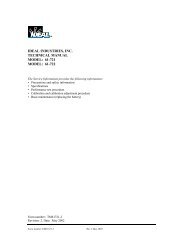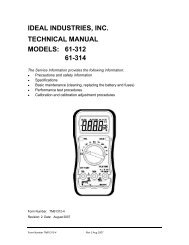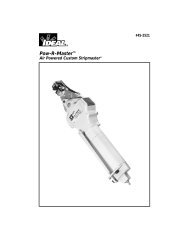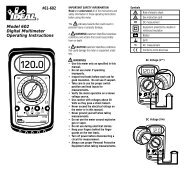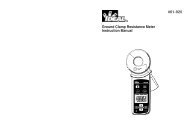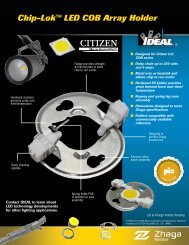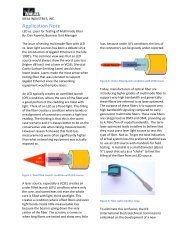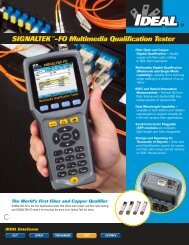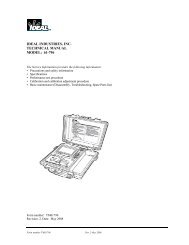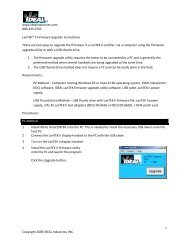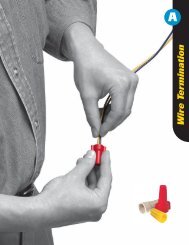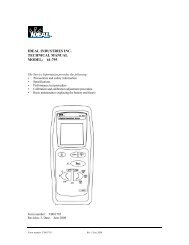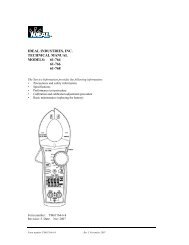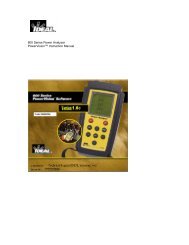LANTEK User Manual - Ideal Industries
LANTEK User Manual - Ideal Industries
LANTEK User Manual - Ideal Industries
You also want an ePaper? Increase the reach of your titles
YUMPU automatically turns print PDFs into web optimized ePapers that Google loves.
Chapter 3<br />
Structured Cable Field Calibration and Testing<br />
TEST SEQUENCE<br />
When the AUTOTEST button is pressed, the following actions occur:<br />
1. The DH firsts attempt to communicate with the RH (Remote Handset) using one<br />
correctly wired pair. If it is unable to establish communication, the DH will display<br />
a message that it is looking for the RH and continue trying until the Autotest is<br />
manually canceled or the RH is found.<br />
2. Once communication with the RH is established, its serial number is checked to see<br />
if current field calibration data exists. If a field calibration has not been performed<br />
in the last 7 days with the RH unit, the Autotest will be aborted and a “Calibration<br />
Required” message will display.<br />
3. If the serial number is valid, the DH will proceed with the specified Autotest. The<br />
first test performed in most Autotests is the Wire Map for twisted pair cable types.<br />
4. After running the Wire Map test, Autotest runs the remaining tests specified for the<br />
currently selected cable type. You have the option of specifying (in Autotest<br />
Preferences) that testing halt after any failed test or proceed through the entire<br />
Autotest series regardless of test failures.<br />
5. Once an Autotest has been completed, all of the test data can be reviewed, saved,<br />
and printed.<br />
‣ The test results for the last Autotest are held in non-volatile memory and<br />
available for review or storage, even after power is cycled off and back on.<br />
‣ The last Autotest results remain in non-volatile memory until they are either<br />
replaced by new test results, the memory is cleared, or any Analyze test is<br />
performed.<br />
SETTING AUTOTEST PREFERENCES<br />
1. Select the Preferences on the Ready screen. The Preferences screen appears.<br />
2. Select Autotest Preferences. The Autotest Preference screen appears.<br />
3. Press the ARROW keys to highlight the desired option.<br />
4. Press to activate or deactivate an option.<br />
5. Press ENTER to accept the selected Autotest Preferences or press ESCAPE to exit<br />
this screen without making changes.<br />
RUNNING AUTOTEST AND UNDERSTANDING RESULTS<br />
Autotest performs comprehensive tests using programmed testing limits. An overall<br />
pass or fail is displayed along with individual test results.<br />
Before beginning Autotesting, connect the Display and Remote handsets to the cable<br />
or link to be tested.<br />
1. Press AUTOTEST. During the Autotest, the handset unit will display a progress<br />
screen.<br />
2. If the RH unit is not found, a “Searching for Remote Handset” warning message is<br />
displayed on the DH. Press ESCAPE to cancel the test and return to the Ready<br />
screen.<br />
3. If the RH is found, Autotest compares the cable test readings to standards for the<br />
cable type selected and issues pass/fail statements for each test.<br />
4. When the Autotest is completed, an overall result of pass or fail is displayed at the<br />
top right of the test information columns. Results for individual tests are displayed<br />
opposite each test name.<br />
3-12



